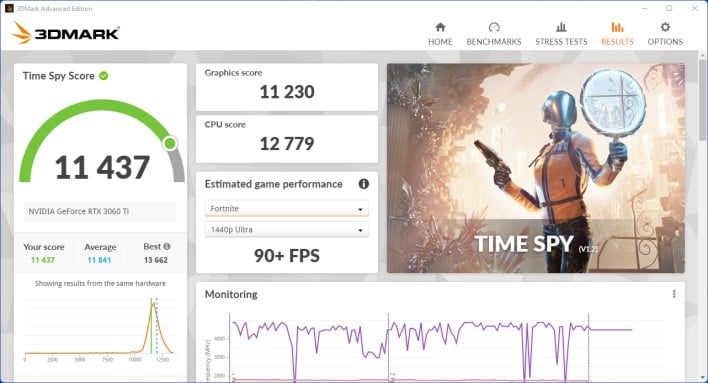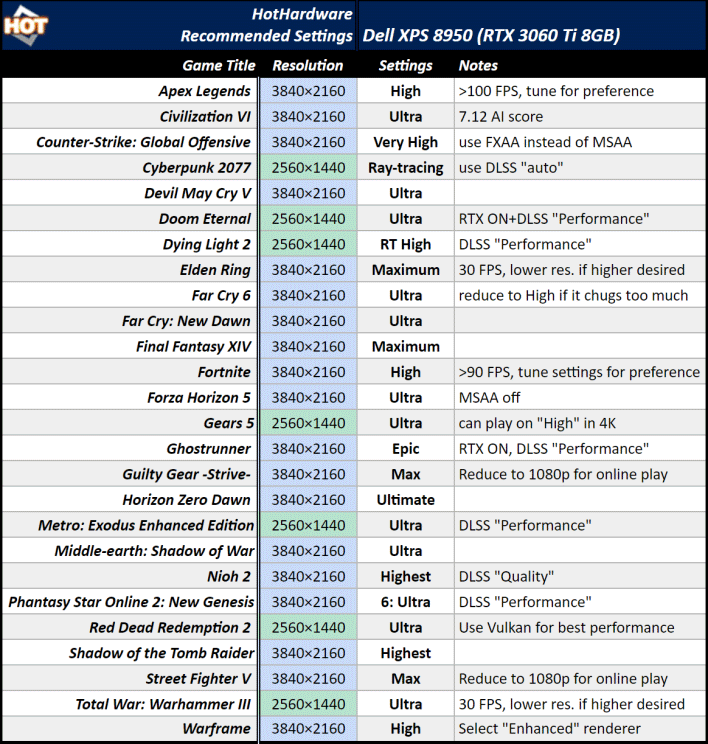Dell XPS Desktop 8950 Review: Intel 12th Gen Tower Of Power
Dell XPS 8950 Desktop: Gaming And Graphics Benchmarks
3DMark is a synthetic game-like benchmark for assessing graphics (GPU) and physics (CPU) performance. This tool has a wide variety of tests and demos that target various types of performance to give a better picture of how a system will handle real games. We used the Time Spy benchmark, 3DMark's DirectX 12 test, to push the XPS 8950. This test has multiple presets, but the standard Time Spy test is plenty taxing. Plus, we have a plethora of reference data, so that's what we stuck with.
3DMark Time Spy DX12 Benchmarks
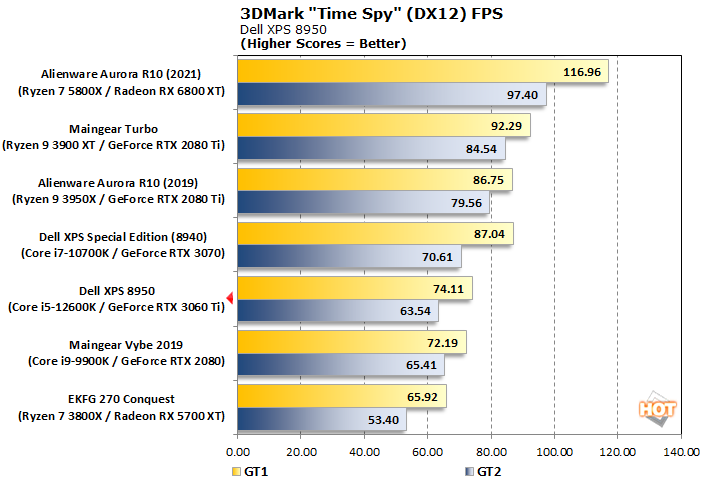
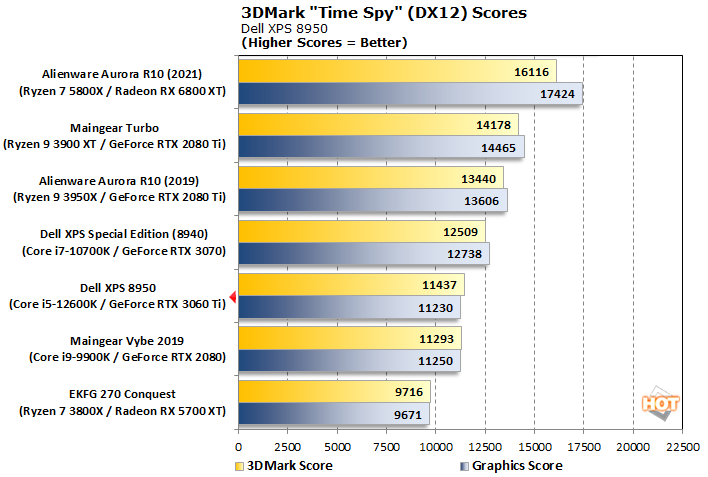
You may recall on the last page how we mentioned the two trends of this review. 3DMark establishes the other: the GeForce RTX 3060 Ti is a lower-powered GPU than those founds in most of our comparison systems, so the XPS 8950 often ends up near the bottom of these charts. This isn't because the XPS 8950 is slow, it's because our review config simply came with a lower tier of GPU than the systems we're comparing it against.
We wanted to make that as clear as possible because the XPS 8950's included GeForce RTX 3060 Ti puts out exactly the kind of performance we expect from an RTX 3060 Ti. There's nothing wrong with it; it's not under-performing. It's just a lower-end GPU option at play here than the other system configs.
With that said, if you know how a GeForce RTX 3060 Ti performs, you pretty much know how this system is going to perform in games. Indeed, in 3DMark, the Dell XPS 8950's result was within 400 points of the average score for this combination of CPU and GPU.
These numbers aren't on the charts, but it's interesting to note that the CPU score in Time Spy was actually quite a bit higher than the Graphics score. As a result, the overall Time Spy score was higher than the individual graphics score, which is pretty unusual.
Middle Earth: Shadow Of War Benchmarks
Middle Earth: Shadow of War is getting a bit long in the tooth, but this fun and beautiful title, set in Tolkien's Lord of the Rings universe, still makes a great test of DirectX 11 performance. To test the XPS 8950 relative to other systems, we set the resolution to 2560x1440 and turned the visuals up to the High preset.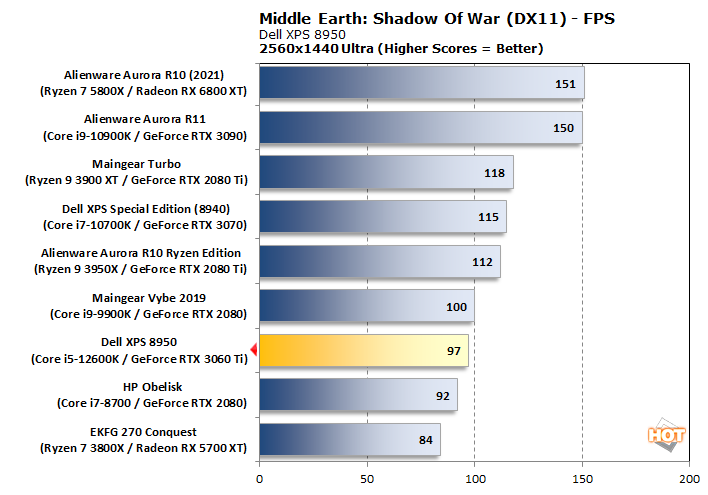
Unsurprisingly, the pattern repeats. There are no showstoppers here; the Dell XPS 8950's GeForce RTX 3060 Ti turns in a very solid performance akin to the Geforce RTX 2080s. 97 FPS is a great experience in this game, but it also gives us considerable headroom. So, how does it fare in 4K?
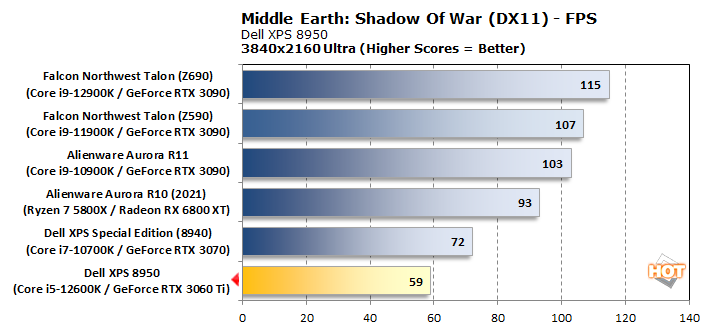
Not bad, actually. While that 59 FPS average isn't flawless—the game suffers a few hitches here and there—it's a more-than-playable experience, especially with the visuals turned up as they are. Also interesting to note is the Radeon RX 6800 XT's fall from grace. Reliant on Infinity Cache as it is, the Radeon GPU can't keep up with its rivals from Team Green at fully eight megapixels.
Shadow Of The Tomb Raider Performance
Shadow of the Tomb Raider is currently the final entry in the Tomb Raider reboot trilogy, although another entry, this time running on Epic's Unreal Engine 5, was just announced last week. Since we don't have comparison data for that newer release, we'll test this one again.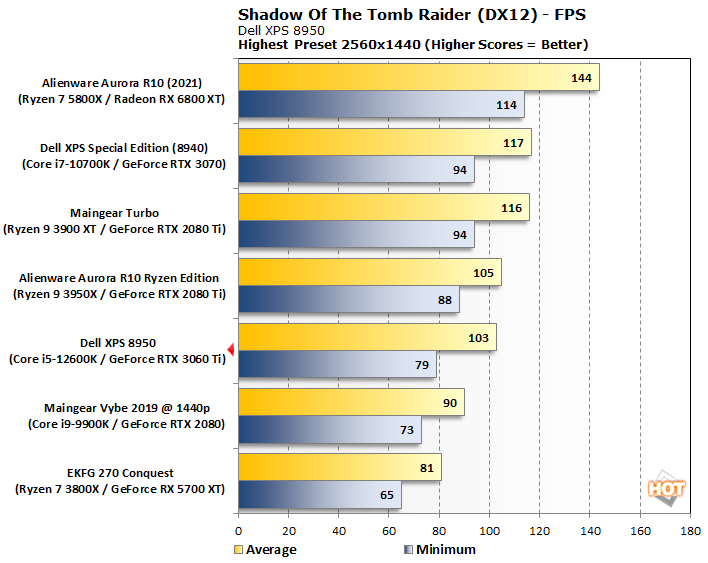
Same story, different game. Dell's XPS 8950 chugs along like a champ, churning out frames from its GeForce RTX 3060 Ti exactly as fast as expected. It just barely edges out the GeForce RTX 2080 in the Maingear Vybe from 2019, although the difference could be down to the three-generations-newer CPU, too.
Gears 5 Benchmarks
Gears of War was a graphical tour de force when it released on the Xbox 360 in 2006. As the showpiece title for Epic's third full-number revision for Unreal Engine 3, it showcased stellar visual effects. Now, 16 years later, Gears 5 may not be similarly stunning, but it's no slouch either and looks pretty great. We skipped the "High" preset testing this time around, and in the interest of brevity went for Ultra.
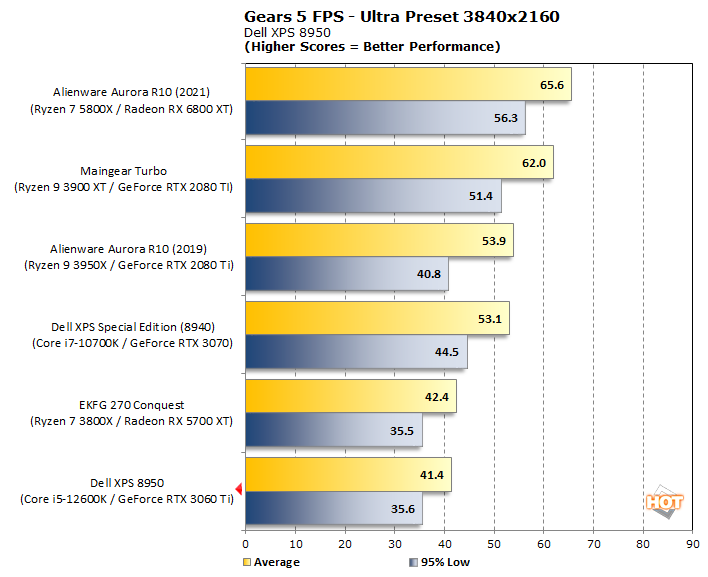
Gears 5 has always had some pretty strange performance characteristics. In 2560×1440, things more or less line up as expected, with the XPS 8950's GeForce RTX 3060 Ti placing it in the lower portions of the chart. Surprisingly, the EKFG 270 Conquest actually places above the Dell XPS 8950 in our 4K testing, although 4K with Ultra settings in this game is sort of academic on both of these machines.
Metro Exodus Benchmarks
Metro Exodus is based on author Dmitry Glukhovsky's series of Metro novels that started with Metro 2033 back in 2005. It's become something of a tradition for the Metro games to receive updated re-releases just a few scant years after the original release, and that's the case for Exodus, too.We're testing with the original release here, though, simply because that's the data we have to compare against. If you were actually going to play Metro Exodus in 2022, we'd definitely recommend the Enhanced Edition, as long as you have the requisite DXR-capable hardware—it both runs and looks better than the original recipe.
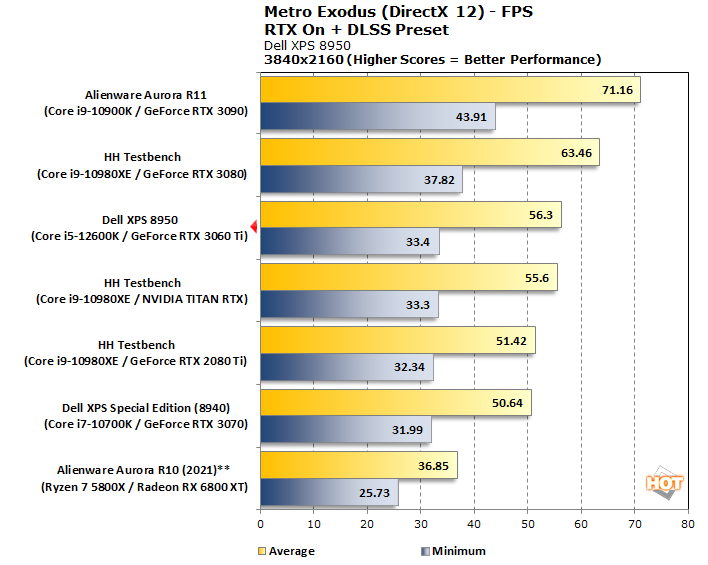
** Note: the Alienware Aurora R10's Radeon RX 6800 XT does not support DLSS.
Thanks to Ampere's ray-tracing refinements, the RTX 3060 Ti in the Dell XPS 8950 manages to outpace not only a GeForce RTX 2080 Ti, but also an NVIDIA TITAN RTX. Oddly, the Dell XPS 8950 also manages to outpace the previous-generation XPS Special Edition, despite that that machine came with a faster GeForce RTX 3070. We're willing to credit that to driver updates, and possibly better thermals, since we ran those previous numbers.
A minimum framerate of 33.4 FPS may not sound that great, but it'll increase quite a bit once you move over to the Enhanced Edition of Metro Exodus. That version of the game is downright smooth on these settings.
Dell XPS 8950 - But Will It Run It This Game? Yeah, probably.
We tested a lot more games than just those four on the Dell XPS 8950. Attempting to tease out any foibles in the system's design, we ran it through the gantlet, trying every kind of title we could think of. So doing, we got a pretty good idea for how the system runs quite a few games.
Above, we've placed a list of tested and confirmed game settings for a raft of popular titles. Where not otherwise indicated, these settings target 60 FPS at the listed resolution, although some run quite a bit better than that.
While we tested these games at these settings, we can't guarantee that every part of each game will run flawlessly with the listed settings. As such, performance may or may not fall below what you consider acceptable with the listed settings, and yes your mileage may vary. The above table is just to give prospective buyers an idea of what kind of performance you can expect out of Dell's XPS 8950 across a myriad of game titles.
A Piece of Re-BAR
When poking around in the system setup trying to turn on XMP memory optimization, we noticed an option for Re-sizeable BAR. BAR in this case stands for "Base Address Register," and without getting too far into the weeds, "Re-sizeable BAR" is a feature that allows the GPU to open up a bigger window into main memory. This can accelerate transfers to the GPU. AMD calls the tech "Smart Access Memory" for its platforms, but it's identical to the base Windows functionality.
The Re-sizeable BAR option on the Dell XPS 8950 defaulted to "off," which we found surprising as, to our knowledge, there are essentially no downsides to having it enabled in this configuration. Admittedly, the benefits of the feature are usually fairly small, but a little extra performance is a little extra performance, right? Here are a few benchmarks we ran with the feature on, and then with it off.

Note that Forza Horizon 5 is not whitelisted by NVIDIA.
We asked Dell why the feature was turned off and were essentially told that there wasn't enough benefit to enabling it. That's actually a reasonable statement, sort of—it's true that it offers very little extra performance, as you can see above. However, once again, there's also virtually no downside (that we're aware of) to having it enabled. Some review testers have found performance regressions with it on, but NVIDIA requires games to be on a whitelist to take advantage of the feature at all.
Dell mentioned this when giving its rationale for not enabling Re-sizeable BAR by default, commenting that "NVIDIA’s GeForce Experience does a good job managing the titles which have Resizable BAR support." The problem is, GeForce Experience can't enable the feature unless it is first enabled in the system BIOS setup utility.
Ultimately, we don't really fault Dell for leaving the feature disabled by default, but we would also recommend anyone who buys a Dell XPS 8950 to go into the system BIOS setup and turn it on.

